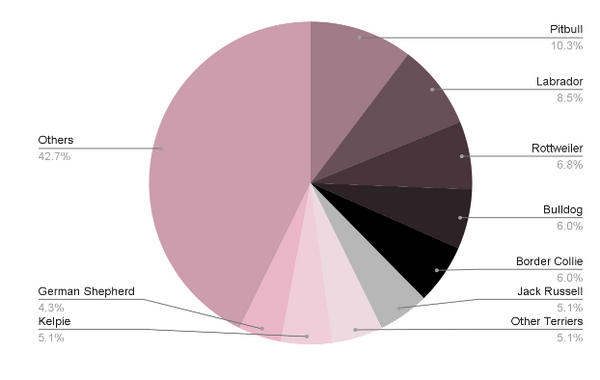AFTERPAY NOW AVAILABLE | CHRISTMAS SALES 30% OFF STORE WIDE - CODE "XMAS30"
AFTERPAY NOW AVAILABLE | CHRISTMAS SALES 30% OFF STORE WIDE - CODE "XMAS30"

When we think of dog bites, it’s always easy to paint dogs as bad guys or dangerous ones. Some even label certain breeds to be aggressive and natural biters. But, in reality, this rarely happens when dogs feel secure.
We must realise that any dog, even the sweetest ones, can have bad days and bite once provoked. After all, like humans, they also come in different personalities and temperaments shaped largely by the environment and treatment they grew up in. Contrary to common belief, genetics explains only about 9% of a dog's individuality.
This means that more than breed factors, dog-related injuries can happen for more complex and varying reasons, can be effectively prevented with proper canine behaviour education, and can be reduced by responsible dog ownership.
So, instead of demonising dogs, we can start addressing the growing number of dog bites by understanding how and why it happens. Starting with these dog bite statistics and facts!
Did you know that approximately 100,000 dog bites are reported in Australia annually?
This comes as no surprise, as dog-related injuries are also prevalent worldwide. In fact, 4.5 million people are bitten by dogs every year in the United States. Although there are no global estimates of dog bites, studies curated by the World Health Organisation (WHO)suggest that there are tens of millions of dog-related injuries annually.
Let’s dive into these numbers to understand better their occurrence and how dog bites impact community life.
85-90% of animal bites are dog bites, followed by cats (5-10%), humans (2-3%), and rodents (2-3%). Other animals with documented bites are native Australian animals and some livestock.
Annually, an average of 2061 hospital admissions in Australia are attributed to dog attacks, with children frequently bitten on the head and older adults experiencing severe injuries, including hip fractures from dog-related falls.
Invading dog territories. Approaching unfamiliar dogs. Stealing toys and dog treats.
With their curiosity and unpredictability, dogs often find children invasive and threatening. That said, a recent report by the Sydney Children’s Hospital disclosed that one child, averaging five years old, is admitted weekly due to dog bites.
What makes this even more alarming is that 74% of these children incurred face, neck, and head injuries, which has a lot to do with their small size and limited ability to defend. This situation primarily urges parents to be more cautious of their children’s activities, especially when dogs are nearby.
Since dog bites are often a result of a dog’s response to threats rather than a malicious attack, most people bitten by dogs only incur non-life-threatening injuries and only worsen when left untreated.
In a rabies-free country like Australia, the dog bite death rate (0.004/100000) is even lower than in the United States (0.05–0.07/100 000) and Canada (0.007/100000).
Previous studies and animal management conference proceedings have estimated that the total cost of managing injuries caused by dog bites in Australian public hospitals exceeds $7 million annually, excluding the dog bite post-traumatic treatment for children.
Intact male dogs, known for their inclination to roam, are more often implicated in dog bites, especially aggression cases, than their neutered counterparts. This is due to testosterone in intact dogs, a behaviour modulator, intensifying reactions to stimulants and their surroundings.
Although desexing has been shown to reduce aggression towards other dogs, limited data are available on its impact on other specific aggressive behaviours.
In the US, 3 of 5 biting incidents involve the victims’ family dogs or dogs owned by neighbours. Only less than 10% were attributed to strays. In fact, when approached, free-ranging owned dogs exhibited higher aggression levels than strays, especially in proximity to their homes.
Similarly, 74% of dog-related injuries in Australia happened at home, and their pet or a familiar animal attacked 66% of individuals bitten by dogs.
This says a lot about how responsible dog ownership can reduce dog bite incidences. If only all pet owners cared enough to socialise and teach their dogs off-leash etiquette adequately.
You might wonder how can a typically amicable dog bite aggressively.
Before you even think about it, we’re telling you it’s less about the breed and more about how people make dogs feel. Dogs might exhibit aggression and bite for various reasons, such as when:
So, the tendency of pet dogs to bite essentially depends on how they’re treated and cared for at home.
Apart from causes, we should also familiarise ourselves with the types of dog bite injuries to provide appropriate first aid and avoid worsening the situation.
These dog bites break the skin, often causing bleeding and infections. In the 2013-2014 report of the Australian Institute of Health and Welfare, 3013 cases were recorded to be open wounds, and 88% of this number had infections and were hospitalised.
People who were bitten and at the same time struck by dogs often incur fractures after falling to the ground or experiencing great pressure from dog attacks. From the same report, 200 Australians bitten by dogs suffered from fractures.
Dog bites can also significantly harm muscles, tissues, ligaments, tendons, and bones. Even when the skin remains intact, a dog bite can still result in a crushing injury that would require immediate medical attention.
Since dog bites can occur on various body parts, including the hand (42%) and head (23%), injuries other than those mentioned may still happen to you.
While dog attacks are documented across various breeds, certain types have shown a higher incidence of biting. However, it's crucial to approach this information without prejudice and recognise that breed does not solely determine a dog's tendency to bite.
Therefore, these statistics should not become a means to stereotype specific breeds as aggressive. Instead, this data can be used to understand and know how to handle dogs better and reduce cases of dog bites.
Pitbulls (10.3%) remain the breed with the most biting incidence in NSW Australia, closely followed by Labradors (8.5%) and Rottweilers (6.8%). Other breeds with significant cases of dog-related injuries are shown in the following chart:

Similarly, a systemic review and meta-analysis study also evaluated dog bite cases from the University of Virginia Health System and Nationwide Children's Hospital (1970 to present) and found that Pitbulls are responsible for most dog bites with an occurrence rate of 22.5%. Coming in second are mixed breeds (21.2%), and lastly, German Shepherds at 17.8% of dog-related injuries.
In any type of dog bite, one thing’s for sure: you’ve got to address it quickly to prevent further infections. But first, you have to know the type of wound you incurred.
After performing first aid and seeking medical attention, get vaccination shots, as a dog's mouth contains billions of bacteria belonging to 700 different types that may not have been removed during primary disinfection. If a stray with an unknown vaccination history bites you, you’re also at risk of contracting rabies.
Tetanus or lockjaw is caused by the bacteriumClostridium tetani, triggering painful muscle contractions and affecting the ability to open the mouth or swallow. It has a fatality rate of 45-50% in developing countries.
Typically, dog bites are not considered tetanus-prone unless they come into contact with contaminated soil.
So, if you haven’t had a Tetanus vaccination shot for the last 10 years or five years (for deep and dirty wounds), your healthcare provider might recommend a tetanus booster shot to be sure.
Untreated rabies is almost always fatal, resulting from a viral infection transmitted through bites or contact with an infected animal's saliva. Early immunisation, preferably within 24 hours but certainly within 72 hours after the bite, is crucial for prevention.
Fortunately, Australia is still one of the few rabies-free countries worldwide. But to be safe, secure rabies immunisation as recommended by healthcare professionals.